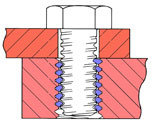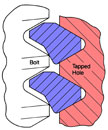Spiralock® Wire Thread Inserts (Tanged)
Spiralock® wire thread inserts are helically coiled fastening devices that provide permanent, wear-resistant screw threads that exceed the strength of most parent material; the inserts are designed to protect tapped holes against failures due to stripping, seizing, corrosion, and wear. Spiralock® inserts are unlike any other wire thread insert due to the fact that our inner diameter wire geometry incorporates our 30° wedge ramp thread form design. Our wire thread inserts are available in two styles: tanged and Drive Notch, engineered with no tang.
Crest of bolt seats against ramp of Spiralock® insert thread profile, preventing transverse movement of bolt relative to insert, thus resisting loosening due to vibration.

|

|

Standard Thread Insert |

Spiralock Thread Insert |
Fast Facts:
- Threads into (Screw Thread Insert) STI holes per NASM33537
- Accepts standard 2A/3A bolts (4g6g and 6g)
- Replaces Helicoil® locking inserts
- Spiralock® insert meets or exceeds the applicable parts of NASM8846; e.g., the wire tensile strength, chemical composition, and methods of inspection
- Spiralock® insert is not a prevailing torque-type screw-locking insert—no risk of galling or seizing of bolt and insert
- Similar to NASM1130 inserts
- Provides proven superior vibration resistance to standard locking inserts
- Duplicates a Spiralock® tapped hole
- Combines the advantages of wire inserts with the vibration resistance and load distribution of Spiralock®
Performance & Features
Spiralock® inserts are made of cold-rolled Type 304 stainless steel wire (AS7245), work-hardened to a tensile strength above 200,000 psi, having a hardness of Rc43-50. The finished surface (8-16 micro inches) is exceedingly smooth, virtually eliminating friction-induced thread erosion.
It is important to select the proper insert length in order to balance the bolt tensile strength against the shear strength of the parent material. The insert lengths are calculated numbers because the inserts cannot be measured in the free state. The lengths are multiples of the nominal thread size, or diameter, of the insert. Please see Table III for insert dimensions. Using the insert length selection table below, an insert length can be selected which will produce a thread system strong enough to fracture a bolt before it will strip or damage either the parent material or the insert.
Recommended Nominal Insert Lengths Based on Parent Material Versus Bolt Material Strengths
Unified
| Shear Strength of Parent Material (KSI) | Bolt Material Minimum Ultimate Tensile Strength (KSI) | ||||||||
|---|---|---|---|---|---|---|---|---|---|
| 54 | 75 | 96 | 108 | 125 | 132 | 160 | 180 | 220 | |
| 10 | 2 | 2-1/2 | 3 | - | - | - | - | - | - |
| 15 | 1-1/2 | 1-1/2 | 2 | 2-1/2 | 2-1/2 | 3 | 3 | - | - |
| 20 | 1 | 1-1/2 | 1-1/2 | 2 | 2 | 2 | 2-1/2 | 3 | 3 |
| 25 | 1 | 1 | 1-1/2 | 1-1/2 | 1-1/2 | 2 | 2 | 2-1/2 | 2-1/2 |
| 30 | 1 | 1 | 1 | 1-1/2 | 1-1/2 | 1-1/2 | 2 | 2 | 2-1/2 |
| 40 | 1 | 1 | 1 | 1 | 1 | 1-1/2 | 1-1/2 | 1-1/2 | 2 |
| 50 | 1 | 1 | 1 | 1 | 1 | 1 | 1 | 1-1/2 | 1-1/2 |
Metric
| Shear Strength of Parent Material MPa (Alum., Mag., Steel) |
Bolt Material Minimum Ultimate Tensile Strength MPa | |||||||
|---|---|---|---|---|---|---|---|---|
| 300 | 400 | 500 | 600 | 800 | 1000 | 1200 | 1400 | |
| 70 | 1-1/2 | 2 | 2-1/2 | 2-1/2 | - | - | - | - |
| 100 | 1 | 1-1/2 | 1-1/2 | 2 | 2-1/2 | 3 | - | - |
| 150 | 1 | 1 | 1-1/2 | 2 | 2 | 2 | 2-1/2 | 3 |
| 200 | 1 | 1 | 1 | 1 | 1-1/2 | 1-1/2 | 2 | 2-1/2 |
| 250 | 1 | 1 | 1 | 1 | 1 | 1-1/2 | 1-1/2 | 2 |
| 300 | 1 | 1 | 1 | 1 | 1 | 1-1/2 | 1-1/2 | 1-1/2 |
| 350 | 1 | 1 | 1 | 1 | 1 | 1 | 1-1/2 | 1-1/2 |
The resilient characteristics of each coil in the Spiralock® insert allow it to adjust independently to secure the maximum surface contact with individual threads in the parent material. As a result, loads are distributed more evenly. Each coil can flex independently to contact the greatest amount of parent material thread surface. Stress and fatigue concentrations are reduced to maximize thread strength and increase the reliability and life of the fastening system. Once installed, the outward spring-like force of the coils holds the insert into place. Furthermore, when the bolt is screwed into the insert and torque is applied, the crests of the bolt will push radially outward on the 30° ramp of the insert’s Spiralock® thread form. The insert will transfer the energy outward into the parent material thereby locking the insert into the material.